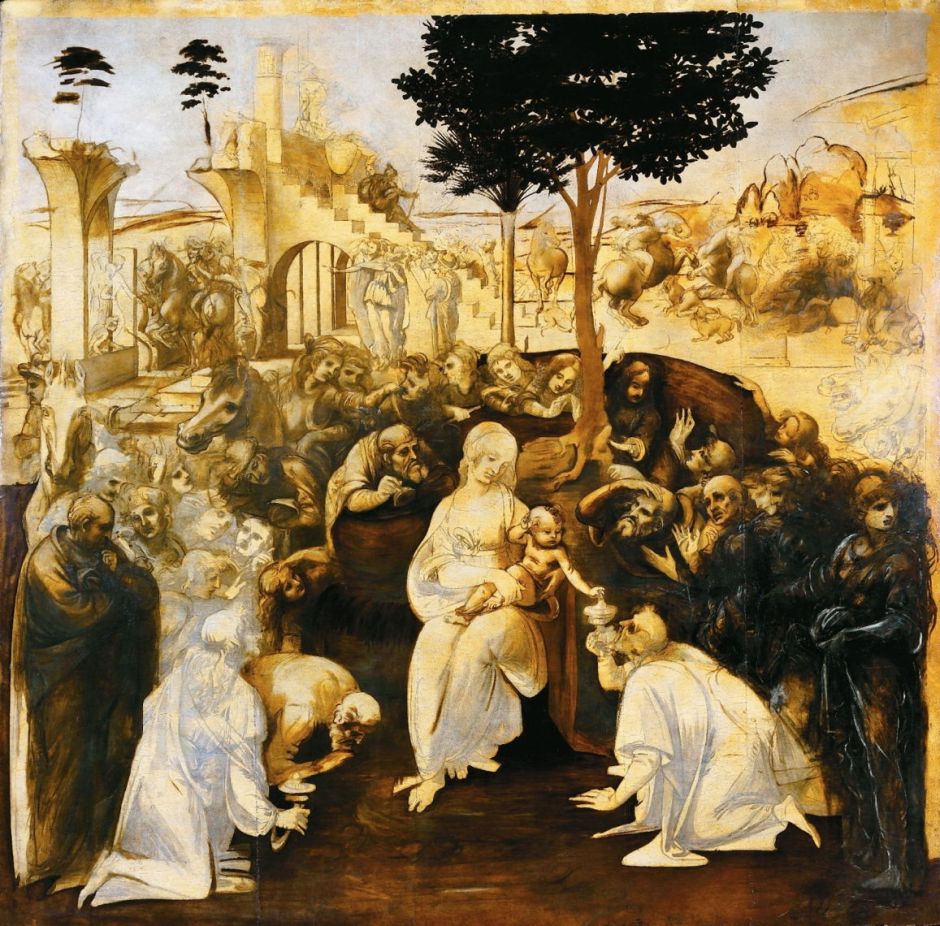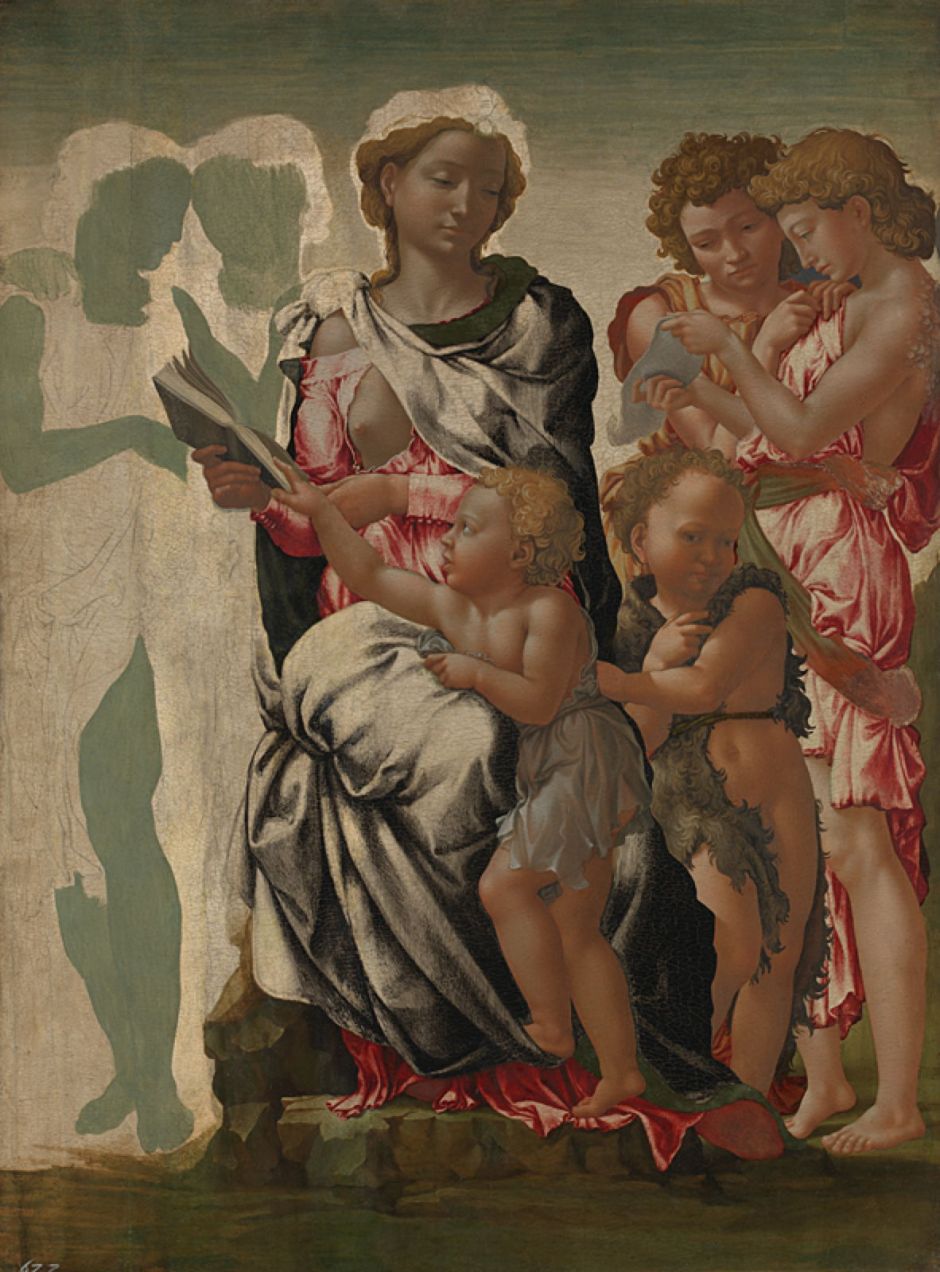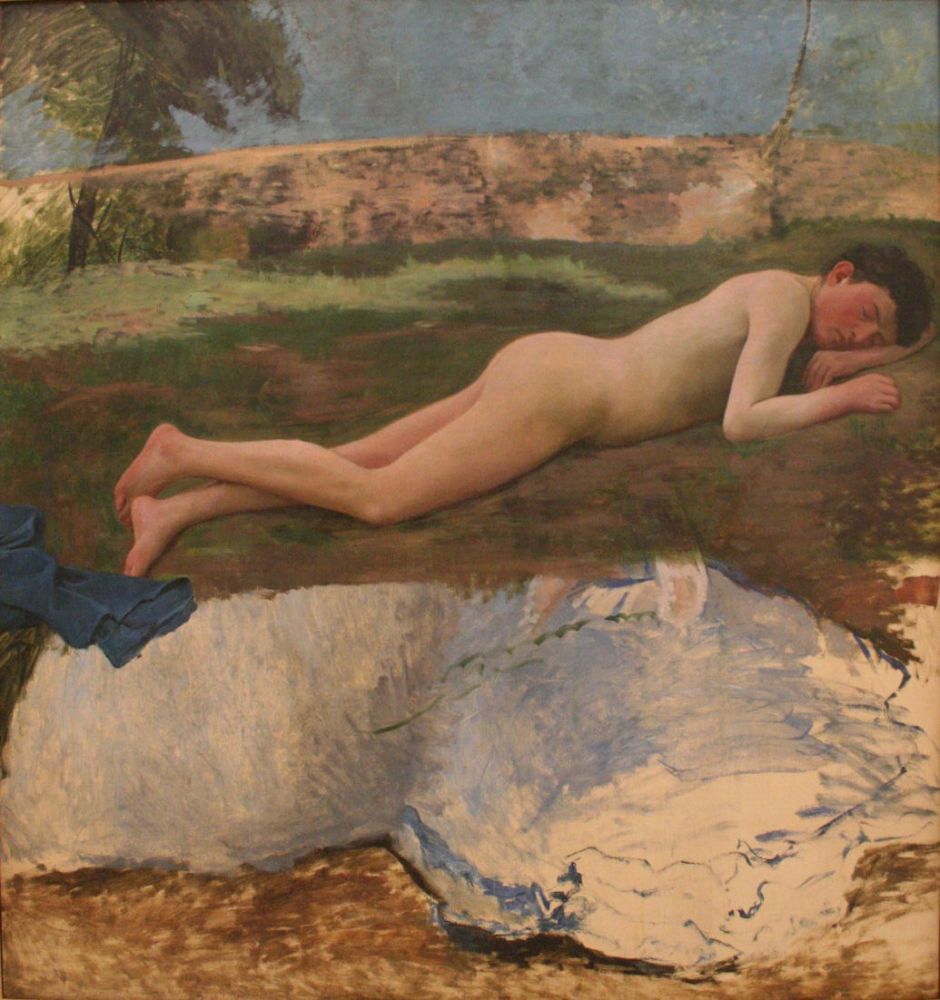Sometimes, either the artist or circumstances prevent us from seeing the painting that was intended, because it’s abandoned incomplete. In some cases, it may be just as well, but incomplete paintings can give us deep insights into the artist’s techniques and materials that are much harder to obtain from finished works. Some aren’t completed because death overcomes the artist first, and they become a sad memorial to a life and art cut short.

Leonardo da Vinci most probably started his final painting of the Adoration of the Magi in or soon after 1480. At nearly 2.5 metres in each dimension, it was going to be one of his largest and most ambitious works to date, but probably had to be abandoned when he left Florence in 1482. Although greatly improved from the first drawing for this work, it was perhaps fortuitous that Leonardo left it behind. However, the geometric arrangement of its four key figures seems to have stuck in the artist’s mind for two of his most famous paintings.

Until his return to Florence in 1499, Michelangelo had primarily been a sculptor. His earliest surviving paintings both appear to have been abandoned, for no apparent reason. The Virgin and Child with Saint John and Angels, popularly known as The Manchester Madonna, from about 1497, shows his skills in modelling flesh and fabrics using egg tempera rather than oils, and is a fine demonstration of the techniques used by a master of the medium.

Michelangelo’s Entombment from about 1500-01 shows comparable processes when working in oils.

Tintoretto’s unfinished sketch for a much larger votive painting of Doge Alvise Mocenigo (1507–1577) Presented to the Redeemer is thought to have been started in about 1571-72. The finished work was intended for the Sala del Collegio in the Doge’s Palace in Venice.

In his tragically brief life, Richard Parkes Bonington produced some remarkable paintings, and his unfinished Venice: The Piazza San Marco (1827-8) shows signs that it might have been among his best. At the time that he started this, Canaletto’s work was still popular and able to command good prices from collectors, and he was perhaps aiming for the same market.
Bonington’s composition is one of the few to recognise the problem of incorporating the height of the Campanile, and attempt a resolution combining proportion and visual effect. The viewer is low down on the south side, gazing up into the sky. The tower, gently distorted by its projection, occupies the right, with the lower Basilica making a formal right angle at its foot. This spares us from the staffage needed to decorate large areas of pavement in the Piazza, which is relegated to the lowest eighth of the canvas. He painted an earlier watercolour to check that this would work.
The buildings have a golden glow from the setting sun, here low in the north-west, but those colours would undoubtedly have been enhanced by rich glazes had Bonington lived long enough to complete it. It’s shocking that, when sold the year after his death, it fetched a mere £18.

In November 1852, when he was in Rome, Nils Jakob Blommér married the Finnish painter Edla Gustafva Jansson (1817-1908). Perhaps prior to their wedding, Blommér started work on this unfinished Portrait of a Woman, believed to show his bride Edla. This is an unusual view that might have been more appropriate as a study for a larger painting including additional figures. Just over two months after their marriage, and before he could complete this portrait, Blommér fell ill with pneumonia, and died on 1 February 1853, at the age of only thirty-six.

Marià Fortuny was commissioned to paint what was intended to form a large diorama showing one of the successes of the Spanish Army during the war in Morocco. He assembled the many sketches which he had made in early 1860, and started painting his vast canvas of The Battle of Tetouan by 1862. Despite working on it intermittently through the rest of his life, Fortuny never completed it. It is almost ten metres (over thirty feet) long.
The objective of the Spanish force assembled in Morocco just before Christmas 1859 was to take the city of Tétouan, to try to prevent raids being launched from there by local Moroccans against the nearby Spanish enclaves of Ceuta and Melilla. The Spanish troops started to advance towards their objective on 1 February 1860, inflicting heavy casualties on the Moroccans in a series of smaller attacks until the city fell on 6 February.
Fortuny’s painting shows the Spanish attacking an Arab camp (to the left) during its advance towards the city. The image below shows a more detailed view of its centre section.

Frédéric Bazille was the most promising figurative painter among the Impressionists, and his work was already starting to have impact on painting well beyond that circle of friends. Within a month of the start of the Franco-Prussian War, Bazille had enlisted in the Third Zouave Regiment. He spent September training with the regiment in Algeria, then returned to fight in France. On 28 November 1870, he was killed at the Battle of Beaune-la-Rolande. He would have celebrated his twenty-ninth birthday just over a week later.

Immediately before he joined up, Bazille had been working on three paintings while staying alone at Méric. He was painting Study for a Young Male Nude over another unfinished painting of two women in a garden, and the lower third of the canvas shows the lower part of their dresses.

When Jules Bastien-Lepage died suddenly in 1884, he left his unfinished painting of Ophelia which he had started in 1881. Her anguish is about to drive her body down into the water, and drown there. At the time of his death, Bastien-Lepage still had to paint all the foreground detail. This would have covered the lower half of the canvas, and given it his usual finely-detailed appearance.
Of all the artists of the nineteenth century, Gustave Moreau must have left the most incomplete paintings, including some started early in his career and left abandoned over forty years later.

There is still controversy over when Moreau started work on this large painting of The Suitors, but it was probably around 1852. Cooke considers that he didn’t work on it in earnest until nearer 1860, after he had returned from Italy and became determined to change history painting. At that stage, it seems to have consisted of a smaller canvas, and he discontinued work on that by about 1864, only to return to it, perhaps intermittently, and then more seriously in the early 1880s, by which time the canvas had been enlarged considerably. He seems to have finally abandoned it in around 1885.

Using drawings made by Moreau in 1860, Cooke argues that the original work was slightly larger than shown in this detail, although even this area changed considerably during Moreau’s later re-working.
This shows the scene in Book 22 of Homer’s Odyssey, when Odysseus returns home to his palace in Ithaca and massacres the many suitors who have occupied it in their efforts to court Odysseus’ wife, Penelope. The overall episode is quite complex in narrative, but Moreau opts for the climax, in which Odysseus is killing the suitors, rather than any of the more involved sub-stories leading up to that.
There are two prominent figures: Odysseus, who was originally holding a bow and standing proud at the top of steps on the right, and Minerva (Pallas Athena) who is in mid-air in the middle of the painting, as Odysseus’ tutelary goddess. By the time the canvas had been enlarged and repainted, Odysseus was lost in the background (he is now shown, still holding his bow, in the doorway at the back, with an owl over his head), and Minerva has become pre-eminent.
Moreau justified this alteration by typifying Odysseus as showing ‘material and brutal force’, but Minerva represented ‘wisdom, moral force’. The suitors, now filling the canvas in their suffering and death, were ‘Last Judgement figures fleeing before the divine thunderbolt’ of Minerva.

Moreau seems to have worked on this unusual painting of Tyrtaeus Singing During the Combat in the early 1860s, abandoned it, then returned to have it enlarged in about 1883, and work it further for a period, before giving it up altogether.

This detail shows much of the original painting, which is full to bursting with androgynous and near-naked young men. The priestess-like figure to the left of the centre appears to be Tyrtaeus, an elegiac Greek poet who lived around the time of the Second Messenian War, in the latter part of the seventh century BCE. He had strong military links and following, and his verse exhorted the Spartans to fight bravely against the Messenians. He is shown here in action, inspiring the young Spartan warriors to victory.
The strange collage-like effect is a combination of Moreau’s emphasis on establishing the form of his figures, and I suspect edge-enhancement in the image’s processing.
This painting has elicited speculation as to how much Moreau may have identified with Tyrtaeus, as he seems to with other classical poets such as Hesiod, and whether the figures should be read as being homoerotic. The latter doesn’t appear to have been proposed with respect to The Suitors; before the depth and duration of Moreau’s relationship with his muse and mistress was appreciated, this may have been more reasonable. Moreau’s unfinished paintings shine no light on the complexity of his art at all, only deepening his mysteries.

Shortly after starting this painting of Demonstrating a Machine Gun in 1942, Eric Ravilious flew to Iceland, where he joined RAF Kaldadarnes on 1 September. The primary role of that remote air station was to monitor the Iceland-Greenland gap, which required flying in some of the most hostile conditions. Losses were high, and on the day of Ravilious’ arrival a Lockheed Hudson failed to return from its patrol. Three aircraft took off at first light the following morning to search, one carrying Ravilious, who had chosen to join its crew. His aircraft also failed to return, and no trace was ever found of it.
Occasionally, there is someone able to complete an unfinished painting.

When Pierre-Paul Prud’hon died two hundred years ago, he left at least one unfinished painting in his studio. He had started work on Andromache and Astyanax in 1813, apparently intending to sell it to the former Empress Marie-Louise, but seems to have abandoned it. His pupil and friend Charles Pompée Le Boulanger de Boisfrémont (1773–1838) completed this painting in 1824, before he vanished into obscurity.

